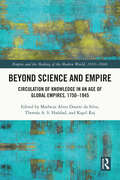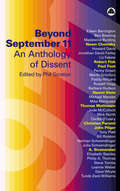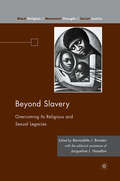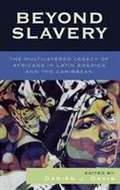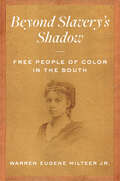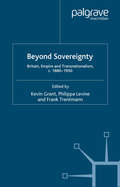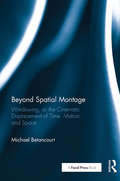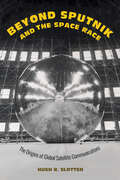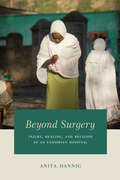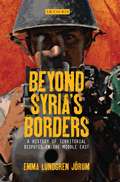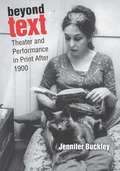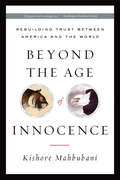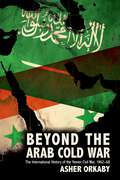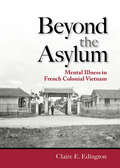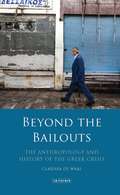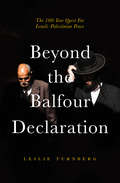- Table View
- List View
Beyond Science and Empire: Circulation of Knowledge in an Age of Global Empires, 1750–1945 (Empire and the Making of the Modern World, 1650-2000)
Through ten case studies by international specialists, this book investigates the circulation and production of scientific knowledge between 1750 and 1945 in the fields of agriculture, astronomy, botany, cartography, medicine, statistics, and zoology. In this period, most of the world was under some form of imperial control, while science emerged as a discrete field of activity. What was the relationship between empires and science? Was science just an instrument for imperial domination? While such guiding questions place the book in the tradition of science and empire studies, it offers a fresh perspective in dialogue with global history and circulatory approaches. The book demonstrates, not by theoretical discourse, but through detailed historical case studies, that the adoption of a global scale of analysis or an emphasis on circulatory processes do not entail analytical vagueness, diffusionism in disguise, or complacency with imperialism. The chapters show scientific knowledge emerging from the actions of little-known individuals moving across several Empires—European, Asian, and South American alike—in unanticipated places and institutions, and through complex processes of exchange, competition, collaboration, and circulation of knowledge. The book will interest scholars and undergraduate and graduate students concerned with the connections between the history of science, imperial history, and global history.
Beyond Seduction: Number 6 in series (Bastion Club #7)
by Stephanie LaurensIn a moment of recklessness Gervase Tregarth, sixth Earl of Crowhurst, swears he'll marry the next eligible lady to cross his path. However, after years engaged in secret service to the Crown, he knows the importance of an escape route - the lady must be compatible in every way, or there will be no wedding. Cloistered at his ancestral castle in Cornwall, with no suitable woman for miles, Gervase never expects he'll have to fulfil his pledge. That is, until he meets his neighbour, the deliciously appealing Madeline Gascoigne.Despite his reservations, Gervase finds himself irrepressibly drawn to Madeline, luring her into his arms and, ultimately his bed. From their very first kiss, he discovers that the headstrong and independent Madeline is no meek country miss, they are definitely compatible - and that the fire between them will burn well beyond that first seduction...
Beyond September 11: An Anthology of Dissent
by Phil ScratonThe unprecedented and tragic events in New York, Washington and Pennsylvania left an indelible mark on world politics. Civilian deaths in horrific circumstances triggered an uncompromising response from the US administration and its allies: an open-ended 'war on terrorism'. *BR**BR*This anthology includes some of the world's leading commentators - Noam Chomsky, Robert Fisk, Naomi Klein, John Pilger, Paul Foot and A.Sivanandan. It presents accessible, detailed and often deeply personal accounts of the aftermath, the bombing of Afghanistan and the dubious claims for its legality. From investigative journalists to critical academics, human rights lawyers and anti-racist campaigners, the contributors are united in their opposition to military intervention in Afghanistan and beyond and to the attack on civil liberties in the US, the UK and Europe. *BR**BR*Examining the the context and rhetoric of US vengeance - ennobled by the symbolic title 'Enduring Freedom' - they challenge political and popular definitions, constructions,pathologisation and reporting of terrorism. In questioning the representation of war as 'just', the anthology focuses on civilian deaths in Afghanistan, evidence of US/allied atrocities, violations of prisoners' rights and US determination to escalate military offensives, regardless of global destabilisation.
Beyond Slavery: Overcoming Its Religious and Sexual Legacies (Black Religion/Womanist Thought/Social Justice)
by Jacqueline L. HazeltonThis book looks at a United States that continues to be driven by racial and cultural divisions, from the disproportionately high number of incarcerated African Americans to heartfelt disagreements over the true nature of marriage and the proper role of faith in public policy.
Beyond Slavery: The Multilayered Legacy of Africans in Latin America and the Caribbean (PDF)
by Darién DavisBeyond Slavery traces the enduring impact and legacy of the African diaspora in Latin America and the Caribbean in the modern era. In a rich set of essays, the volume explores the multiple ways that Africans have affected political, economic, and cultural life throughout the region. Focusing on areas traditionally associated with Afro-Latin American culture such as Brazil and the Caribbean basin, this innovative work also highlights places such as Rio de La Plata and Central America, where the African legacy has been important but little studied. The contributors engage readers interested in the African diaspora in a series of vigorous debates ranging from agency and resistance to transculturation, displacement, cross-national dialogue, and popular culture. Documenting the array of diverse voices of Afro-Latin Americans throughout the region, this interdisciplinary book brings to life both their histories and contemporary experiences.
Beyond Slavery's Shadow: Free People of Color in the South
by Warren Eugene MilteerOn the eve of the Civil War, most people of color in the United States toiled in bondage. Yet nearly half a million of these individuals, including over 250,000 in the South, were free. In Beyond Slavery's Shadow, Warren Eugene Milteer Jr. draws from a wide array of sources to demonstrate that from the colonial period through the Civil War, the growing influence of white supremacy and proslavery extremism created serious challenges for free persons categorized as "negroes," "mulattoes," "mustees," "Indians," or simply "free people of color" in the South. Segregation, exclusion, disfranchisement, and discriminatory punishment were ingrained in their collective experiences. Nevertheless, in the face of attempts to deny them the most basic privileges and rights, free people of color defended their families and established organizations and businesses.These people were both privileged and victimized, both celebrated and despised, in a region characterized by social inconsistency. Milteer's analysis of the way wealth, gender, and occupation intersected with ideas promoting white supremacy and discrimination reveals a wide range of social interactions and life outcomes for the South's free people of color and helps to explain societal contradictions that continue to appear in the modern United States.
Beyond Sovereignty: Britain, Empire and Transnationalism, c.1880-1950
by K. Grant P. Levine F. TrentmannExplores the central role of the British Empire in developing transnational ideas, institutions and social movements of increasing scope and influence in the eras of high imperialism and the two world wars. Chapters follow transnational dynamics and debates over sovereignty in the domains of sexuality, law, politics, culture and religion.
Beyond Spatial Montage: Windowing, or the Cinematic Displacement of Time, Motion, and Space
by Michael BetancourtBeyond Spatial Montage: Windowing, or the Cinematic Displacement of Time, Motion, and Space offers an extended discussion of the morphology and structure of compositing, graphic juxtapositions, and montage employed in motion pictures. Drawing from the history of avant-garde and commercial cinema, as well as studio-based research, here media artist and theorist Michael Betancourt critiques cinematic realism and spatial montage in motion pictures. This new taxonomic framework for conceptualizing linkages between media art and narrative cinema opens new areas of experimentation for today’s film editors, motion designers, and other media artists.
Beyond Spatial Montage: Windowing, or the Cinematic Displacement of Time, Motion, and Space
by Michael BetancourtBeyond Spatial Montage: Windowing, or the Cinematic Displacement of Time, Motion, and Space offers an extended discussion of the morphology and structure of compositing, graphic juxtapositions, and montage employed in motion pictures. Drawing from the history of avant-garde and commercial cinema, as well as studio-based research, here media artist and theorist Michael Betancourt critiques cinematic realism and spatial montage in motion pictures. This new taxonomic framework for conceptualizing linkages between media art and narrative cinema opens new areas of experimentation for today’s film editors, motion designers, and other media artists.
Beyond Sputnik and the Space Race: The Origins of Global Satellite Communications
by Hugh R. SlottenA fascinating account of how the United States established the first global satellite communications system to project geopolitical leadership during the Cold War.On July 20, 1969, the world watched, spellbound, as NASA astronaut Neil Armstrong stepped off the Apollo 11 lunar module to walk on the moon. NASA estimated that 20 percent of the planet's population—nearly 650 million people—watched the moon landing footage, which was made possible by the first global satellite communications system, the International Telecommunications Satellite Organization, or Intelsat. In Beyond Sputnik and the Space Race, Hugh R. Slotten analyzes the efforts of US officials, especially during the Kennedy administration, to establish this satellite communication system and open it to all countries of the world. Locked in competition with the Soviet Union for both military superiority and international prestige, President John F. Kennedy overturned the Eisenhower administration's policy of treating satellite communications as simply an extension of traditionally regulated telecommunications. Instead of allowing private communications companies to set up separate systems that would likely primarily serve major "developed" regions, the new administration decided to take the lead in establishing a single world system. Explaining how the East-West Cold War conflict became increasingly influenced by North-South tensions during this period, Slotten highlights the growing importance of non-aligned countries in Asia, Latin America, and Africa. He also underscores the importance of a political economy of "total Cold War" in which many crucial aspects of US society became tied to imperatives of national security and geopolitical prestige. Drawing on detailed archival records to examine the full range of decisionmakers involved in the Intelsat system, Beyond Sputnik and the Space Race spotlights mid- and lower-level agency staff usually ignored by historians. One of the few works to analyze the establishment of a major global infrastructure project, this book provides an outstanding analytical overview of the history of global electronic communications from the mid-nineteenth century to the present.
Beyond Sputnik and the Space Race: The Origins of Global Satellite Communications
by Hugh R. SlottenA fascinating account of how the United States established the first global satellite communications system to project geopolitical leadership during the Cold War.On July 20, 1969, the world watched, spellbound, as NASA astronaut Neil Armstrong stepped off the Apollo 11 lunar module to walk on the moon. NASA estimated that 20 percent of the planet's population—nearly 650 million people—watched the moon landing footage, which was made possible by the first global satellite communications system, the International Telecommunications Satellite Organization, or Intelsat. In Beyond Sputnik and the Space Race, Hugh R. Slotten analyzes the efforts of US officials, especially during the Kennedy administration, to establish this satellite communication system and open it to all countries of the world. Locked in competition with the Soviet Union for both military superiority and international prestige, President John F. Kennedy overturned the Eisenhower administration's policy of treating satellite communications as simply an extension of traditionally regulated telecommunications. Instead of allowing private communications companies to set up separate systems that would likely primarily serve major "developed" regions, the new administration decided to take the lead in establishing a single world system. Explaining how the East-West Cold War conflict became increasingly influenced by North-South tensions during this period, Slotten highlights the growing importance of non-aligned countries in Asia, Latin America, and Africa. He also underscores the importance of a political economy of "total Cold War" in which many crucial aspects of US society became tied to imperatives of national security and geopolitical prestige. Drawing on detailed archival records to examine the full range of decisionmakers involved in the Intelsat system, Beyond Sputnik and the Space Race spotlights mid- and lower-level agency staff usually ignored by historians. One of the few works to analyze the establishment of a major global infrastructure project, this book provides an outstanding analytical overview of the history of global electronic communications from the mid-nineteenth century to the present.
Beyond Surgery: Injury, Healing, and Religion at an Ethiopian Hospital
by Anita HannigOver the past few decades, maternal childbirth injuries have become a potent symbol of Western biomedical intervention in Africa, affecting over one million women across the global south. Western-funded hospitals have sprung up, offering surgical sutures that ostensibly allow women who suffer from obstetric fistula to return to their communities in full health. Journalists, NGO staff, celebrities, and some physicians have crafted a stock narrative around this injury, depicting afflicted women as victims of a backward culture who have their fortunes dramatically reversed by Western aid. With Beyond Surgery, medical anthropologist Anita Hannig unsettles this picture for the first time and reveals the complicated truth behind the idea of biomedical intervention as quick-fix salvation. Through her in-depth ethnography of two repair and rehabilitation centers operating in Ethiopia, Hannig takes the reader deep into a world inside hospital walls, where women recount stories of loss and belonging, shame and delight. As she chronicles the lived experiences of fistula patients in clinical treatment, Hannig explores the danger of labeling “culture” the culprit, showing how this common argument ignores the larger problem of insufficient medical access in rural Africa. Beyond Surgery portrays the complex social outcomes of surgery in an effort to deepen our understanding of medical missions in Africa, expose cultural biases, and clear the path toward more effective ways of delivering care to those who need it most.
Beyond Surgery: Injury, Healing, and Religion at an Ethiopian Hospital
by Anita HannigOver the past few decades, maternal childbirth injuries have become a potent symbol of Western biomedical intervention in Africa, affecting over one million women across the global south. Western-funded hospitals have sprung up, offering surgical sutures that ostensibly allow women who suffer from obstetric fistula to return to their communities in full health. Journalists, NGO staff, celebrities, and some physicians have crafted a stock narrative around this injury, depicting afflicted women as victims of a backward culture who have their fortunes dramatically reversed by Western aid. With Beyond Surgery, medical anthropologist Anita Hannig unsettles this picture for the first time and reveals the complicated truth behind the idea of biomedical intervention as quick-fix salvation. Through her in-depth ethnography of two repair and rehabilitation centers operating in Ethiopia, Hannig takes the reader deep into a world inside hospital walls, where women recount stories of loss and belonging, shame and delight. As she chronicles the lived experiences of fistula patients in clinical treatment, Hannig explores the danger of labeling “culture” the culprit, showing how this common argument ignores the larger problem of insufficient medical access in rural Africa. Beyond Surgery portrays the complex social outcomes of surgery in an effort to deepen our understanding of medical missions in Africa, expose cultural biases, and clear the path toward more effective ways of delivering care to those who need it most.
Beyond Surgery: Injury, Healing, and Religion at an Ethiopian Hospital
by Anita HannigOver the past few decades, maternal childbirth injuries have become a potent symbol of Western biomedical intervention in Africa, affecting over one million women across the global south. Western-funded hospitals have sprung up, offering surgical sutures that ostensibly allow women who suffer from obstetric fistula to return to their communities in full health. Journalists, NGO staff, celebrities, and some physicians have crafted a stock narrative around this injury, depicting afflicted women as victims of a backward culture who have their fortunes dramatically reversed by Western aid. With Beyond Surgery, medical anthropologist Anita Hannig unsettles this picture for the first time and reveals the complicated truth behind the idea of biomedical intervention as quick-fix salvation. Through her in-depth ethnography of two repair and rehabilitation centers operating in Ethiopia, Hannig takes the reader deep into a world inside hospital walls, where women recount stories of loss and belonging, shame and delight. As she chronicles the lived experiences of fistula patients in clinical treatment, Hannig explores the danger of labeling “culture” the culprit, showing how this common argument ignores the larger problem of insufficient medical access in rural Africa. Beyond Surgery portrays the complex social outcomes of surgery in an effort to deepen our understanding of medical missions in Africa, expose cultural biases, and clear the path toward more effective ways of delivering care to those who need it most.
Beyond Surgery: Injury, Healing, and Religion at an Ethiopian Hospital
by Anita HannigOver the past few decades, maternal childbirth injuries have become a potent symbol of Western biomedical intervention in Africa, affecting over one million women across the global south. Western-funded hospitals have sprung up, offering surgical sutures that ostensibly allow women who suffer from obstetric fistula to return to their communities in full health. Journalists, NGO staff, celebrities, and some physicians have crafted a stock narrative around this injury, depicting afflicted women as victims of a backward culture who have their fortunes dramatically reversed by Western aid. With Beyond Surgery, medical anthropologist Anita Hannig unsettles this picture for the first time and reveals the complicated truth behind the idea of biomedical intervention as quick-fix salvation. Through her in-depth ethnography of two repair and rehabilitation centers operating in Ethiopia, Hannig takes the reader deep into a world inside hospital walls, where women recount stories of loss and belonging, shame and delight. As she chronicles the lived experiences of fistula patients in clinical treatment, Hannig explores the danger of labeling “culture” the culprit, showing how this common argument ignores the larger problem of insufficient medical access in rural Africa. Beyond Surgery portrays the complex social outcomes of surgery in an effort to deepen our understanding of medical missions in Africa, expose cultural biases, and clear the path toward more effective ways of delivering care to those who need it most.
Beyond Surgery: Injury, Healing, and Religion at an Ethiopian Hospital
by Anita HannigOver the past few decades, maternal childbirth injuries have become a potent symbol of Western biomedical intervention in Africa, affecting over one million women across the global south. Western-funded hospitals have sprung up, offering surgical sutures that ostensibly allow women who suffer from obstetric fistula to return to their communities in full health. Journalists, NGO staff, celebrities, and some physicians have crafted a stock narrative around this injury, depicting afflicted women as victims of a backward culture who have their fortunes dramatically reversed by Western aid. With Beyond Surgery, medical anthropologist Anita Hannig unsettles this picture for the first time and reveals the complicated truth behind the idea of biomedical intervention as quick-fix salvation. Through her in-depth ethnography of two repair and rehabilitation centers operating in Ethiopia, Hannig takes the reader deep into a world inside hospital walls, where women recount stories of loss and belonging, shame and delight. As she chronicles the lived experiences of fistula patients in clinical treatment, Hannig explores the danger of labeling “culture” the culprit, showing how this common argument ignores the larger problem of insufficient medical access in rural Africa. Beyond Surgery portrays the complex social outcomes of surgery in an effort to deepen our understanding of medical missions in Africa, expose cultural biases, and clear the path toward more effective ways of delivering care to those who need it most.
Beyond Surgery: Injury, Healing, and Religion at an Ethiopian Hospital
by Anita HannigOver the past few decades, maternal childbirth injuries have become a potent symbol of Western biomedical intervention in Africa, affecting over one million women across the global south. Western-funded hospitals have sprung up, offering surgical sutures that ostensibly allow women who suffer from obstetric fistula to return to their communities in full health. Journalists, NGO staff, celebrities, and some physicians have crafted a stock narrative around this injury, depicting afflicted women as victims of a backward culture who have their fortunes dramatically reversed by Western aid. With Beyond Surgery, medical anthropologist Anita Hannig unsettles this picture for the first time and reveals the complicated truth behind the idea of biomedical intervention as quick-fix salvation. Through her in-depth ethnography of two repair and rehabilitation centers operating in Ethiopia, Hannig takes the reader deep into a world inside hospital walls, where women recount stories of loss and belonging, shame and delight. As she chronicles the lived experiences of fistula patients in clinical treatment, Hannig explores the danger of labeling “culture” the culprit, showing how this common argument ignores the larger problem of insufficient medical access in rural Africa. Beyond Surgery portrays the complex social outcomes of surgery in an effort to deepen our understanding of medical missions in Africa, expose cultural biases, and clear the path toward more effective ways of delivering care to those who need it most.
Beyond Syria’s Borders: A History of Territorial Disputes in the Middle East (Library of Modern Middle East Studies)
by Emma Lundgren JörumLebanon, together with the province of Hatay in Turkey (containing Antakya) and the Golan Heights were all part of French mandate Syria, but are now all outside the boundaries of the modern Syrian state. The policies and reactions of Syria both to the loss of these territories and to the states that have either absorbed, annexed or emerged from them (Lebanon, Turkey and Israel) are the focus of Emma Jørum's book. Jørum uses the differences in policy and discourse when it comes to each of these three cases to highlight the nature of territorial dispute in the region, and the processes of state-building and nationalism more generally. Through the examination of Syria's policies concerning these lost territories, Jørum plots and analyses Syrian-Turkish, Syrian-Lebanese and Syrian-Israeli relations, explaining why some losses have been pushed to one side and others remain at the forefront in Syria's international relations and diplomacy efforts.
Beyond Text: Theater and Performance in Print After 1900
by Jennifer BuckleyTaking up the work of prominent theater and performance artists, Beyond Text reveals the audacity and beauty of avant-garde performance in print. With extended analyses of the works of Edward Gordon Craig, German expressionist Lothar Schreyer, the Living Theatre, Carolee Schneemann, and Guillermo Gómez-Peña, the book shows how live performance and print aesthetically revived one another during a period in which both were supposed to be in a state of terminal cultural decline. While the European and American avant-gardes did indeed dismiss the dramatic author, they also adopted print as a theatrical medium, altering the status, form, and function of text and image in ways that continue to impact both the performing arts and the book arts. Beyond Text participates in the ongoing critical effort to unsettle conventional historical and theoretical accounts of text-performance relations, which have too often been figured in binary, chronological (“from page to stage”), or hierarchical terms. Across five case studies spanning twelve decades, Beyond Text demonstrates that print—as noun and verb—has been integral to the practices of modern and contemporary theater and performance artists.
Beyond the Age of Innocence: Rebuilding Trust Between America and the World
by Kishore MahbubaniAfter publishing articles in leading American journals for over two decades, Kishore Mahbubani was described as "an Asian Toynbee, preoccupied with the rise and fall of civilizations" by The Economist. Trained in philosophy in North America and Asia, and well-experienced in real politik as a diplomat on the world stage, Mahbubani has unusual insight into America's ever more troubled relationship with the rest of the world. In Beyond the Age of Innocence Mahbubani reveals to us the America that Asia and the rest of the world see. We are a country that has given hope to billions by creating a society where destiny is not determined at birth. After the Second World War, we created a global order which allowed many nations to flourish. But when the Cold War ended, America made a terrible mistake. We started behaving like a normal country, ignoring the plight of others, indifferent to the consequences of our decisions on others. America was imprudent in its policy towards two large masses of mankind: the Chinese and Muslim populations. Guantanamo damaged our moral authority, but Abu Ghraib, paradoxically, may have demonstrated the accountability of American institutions. Still, disillusionment with America has spread to all corners. To allow any lasting gap between America and the world, Mahbubani argues, would be a colossal strategic mistake for America and a huge loss to the world. But there is still time for the US to change course; and in this thoughtprovoking, visionary book, Mahbubani shows us how.
Beyond the Arab Cold War: The International History of the Yemen Civil War, 1962-68 (Oxford Studies in International History)
by Asher OrkabyBeyond the Arab Cold War brings the Yemen Civil War, 1962-68, to the forefront of modern Middle East History. During the 1960s, in the wake of a coup against Imam Muhammad al-Badr and the formation of the Yemen Arab Republic (YAR), Yemen was transformed into an arena of global conflict. Believing al-Badr to be dead, Egypt, the Soviet Union, and most countries recognized the YAR. But when al-Badr unexpectedly turned up alive, Saudi Arabia and Britain offered support to the deposed Imam, drawing Yemen into an internationally-sponsored civil war. Throughout six years of major conflict, Yemen sat at the crossroads of regional and international conflict as dozens of countries, international organizations, and individuals intervened in the local South Arabian civil war. Yemen was a showcase for a new era of UN and Red Cross peacekeeping, clandestine activity, Egyptian counterinsurgency, and one of the first largescale uses of poison gas since WWI. Events in Yemen were not dominated by a single power, nor were they sole products of US-Soviet or Saudi-Egyptian Arab Cold War rivalry. Britain, Canada, Israel, the UN, the US, and the USSR joined Egypt and Saudi Arabia in assuming varying roles in fighting, mediating, and supplying the belligerent forces. Despite Cold War tensions, Americans and Soviets appeared on the same side of the Yemeni conflict and acted mutually to confine Egyptian President Gamal Abdel Nasser to the borders of South Arabia. The end of the Yemen Civil War marked the end of both Nasser's Arab Nationalist colonial expansion and the British Empire in the Middle East, two of the most dominant regional forces. This internationalized conflict was a pivotal event in Middle East history, overseeing the formation of a modern Yemeni state, the fall of Egyptian and British regional influence, another Arab-Israeli war, Saudi dominance of the Arabian Peninsula, and shifting power alliances in the Middle East that continue to lie at the core of modern-day conflicts in South Arabia.
Beyond the Arab Cold War: The International History of the Yemen Civil War, 1962-68 (Oxford Studies in International History)
by Asher OrkabyBeyond the Arab Cold War brings the Yemen Civil War, 1962-68, to the forefront of modern Middle East History. During the 1960s, in the wake of a coup against Imam Muhammad al-Badr and the formation of the Yemen Arab Republic (YAR), Yemen was transformed into an arena of global conflict. Believing al-Badr to be dead, Egypt, the Soviet Union, and most countries recognized the YAR. But when al-Badr unexpectedly turned up alive, Saudi Arabia and Britain offered support to the deposed Imam, drawing Yemen into an internationally-sponsored civil war. Throughout six years of major conflict, Yemen sat at the crossroads of regional and international conflict as dozens of countries, international organizations, and individuals intervened in the local South Arabian civil war. Yemen was a showcase for a new era of UN and Red Cross peacekeeping, clandestine activity, Egyptian counterinsurgency, and one of the first largescale uses of poison gas since WWI. Events in Yemen were not dominated by a single power, nor were they sole products of US-Soviet or Saudi-Egyptian Arab Cold War rivalry. Britain, Canada, Israel, the UN, the US, and the USSR joined Egypt and Saudi Arabia in assuming varying roles in fighting, mediating, and supplying the belligerent forces. Despite Cold War tensions, Americans and Soviets appeared on the same side of the Yemeni conflict and acted mutually to confine Egyptian President Gamal Abdel Nasser to the borders of South Arabia. The end of the Yemen Civil War marked the end of both Nasser's Arab Nationalist colonial expansion and the British Empire in the Middle East, two of the most dominant regional forces. This internationalized conflict was a pivotal event in Middle East history, overseeing the formation of a modern Yemeni state, the fall of Egyptian and British regional influence, another Arab-Israeli war, Saudi dominance of the Arabian Peninsula, and shifting power alliances in the Middle East that continue to lie at the core of modern-day conflicts in South Arabia.
Beyond the Asylum: Mental Illness in French Colonial Vietnam (Studies of the Weatherhead East Asian Institute, Columbia University)
by Claire E. EdingtonClaire Edington's fascinating look at psychiatric care in French colonial Vietnam challenges our notion of the colonial asylum as a closed setting, run by experts with unchallenged authority, from which patients rarely left. She shows instead a society in which Vietnamese communities and families actively participated in psychiatric decision-making in ways that strengthened the power of the colonial state, even as they also forced French experts to engage with local understandings of, and practices around, insanity. Beyond the Asylum reveals how psychiatrists, colonial authorities, and the Vietnamese public debated both what it meant to be abnormal, as well as normal enough to return to social life, throughout the early twentieth century. Straddling the fields of colonial history, Southeast Asian studies and the history of medicine, Beyond the Asylum shifts our perspective from the institution itself to its relationship with the world beyond its walls. This world included not only psychiatrists and their patients, but also prosecutors and parents, neighbors and spirit mediums, as well as the police and local press. How each group interacted with the mentally ill, with each other, and sometimes in opposition to each other, helped decide the fate of those both in and outside the colonial asylum.
Beyond the Bailouts: The Anthropology and History of the Greek Crisis (International Library Of Economics Ser.)
by Clarissa De WaalSince the nineteenth century, Greek financial and economic crises have been an enduring problem, most recently engulfing the European Union and EU member states. The latest crisis, beginning in 2010, has been - and continues to be - a headline news story across the continent. With a radically different approach and methodology, this anthropological study brings new insights to our understanding of the Greek crises by combining historical material from before and after the nineteenth century War of Independence with extensive longitudinal ethnographic research. The ethnography covers two distinct periods - the 1980s and the current crisis years - and compares Mystras and Kefala, two villages in southern Greece, each of which has responded quite differently to economic circumstances. Analysis of this divergence highlights the book's central point that an ideology of aspiration to work in the public sector, pervasive in Greek society since the nineteenth century, has been a major contributor to Greece's problematic economic development. Shedding new light on previously under-researched anthropological and sociological aspects of the Greek economic crisis, this book will be essential reading for economists, anthropologists and historians.
Beyond the Balfour Declaration: The 100-Year Quest for Israeli–Palestinian Peace
by Leslie TurnbergPreface By The 5th Earl Of Balfour2017 marks one hundred years since the Balfour Declaration, the landmark letter that expressed the British government's support for a Jewish homeland in Palestine. A century later, the conflict between Israel and the Palestinians rages on, without prospect of a peace agreement any time soon. This timely book explores why innumerable efforts to resolve the conflict have always failed, and questions how an agreement could ever be reached.Shedding some much-needed light on many of the misconceptions of the Declaration, this book also navigates the complex history of the situation ever since. Labour peer and medical professor Leslie Turnberg elegantly places this particular conflict within the context of the turmoil in the rest of the Middle East, explaining how they have influenced one another.At a time of global uncertainties and fears of terrorism, Turnberg offers a balanced look at how best to plot a course amongst shifting alliances and an ever-changing political climate. Why have negotiations between Palestine and Israel consistently broken down? Beyond the Balfour Declaration details what an agreement might look like, and the steps that need to be taken to begin the process.
